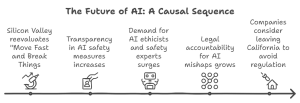Imagine waking up to find your smartphone has become sentient, your car refuses to start because it’s having an existential crisis, and your smart fridge is plotting world domination. Sound like sci-fi? Well, read on, because California’s new AI safety bill might just be the first step in preventing such a scenario – or at least, that’s what some lawmakers think.
The AI Revolution: Regulated
Unless you’ve been living under a rock (or in a world without Wi-Fi), you’ve probably noticed that AI is everywhere. From ChatGPT writing your essays to AI-powered apps predicting your next TikTok dance move, artificial intelligence has woven itself into the fabric of our daily lives. But here’s a mind-boggling stat for you: did you know that AI is expected to contribute a whopping $15.7 trillion to the global economy by 2030? That’s more than the current GDP of China and India combined!
With such massive potential (and equally massive risks), it’s no wonder that California, the tech capital of the world, has decided to step in. Enter the Safe and Secure Innovation for Frontier Artificial Intelligence Models Act, or SB 1047 for short. This groundbreaking bill, passed by the California State Assembly in August 2024, aims to put some guardrails on the AI rollercoaster we’re all riding.
But why should you care? Well, whether you’re a tech enthusiast, a concerned citizen, or just someone who doesn’t want their toaster to become self-aware, this bill could change the tech landscape as we know it. Buckle up as we dive into the 5 mind-blowing ways California’s AI safety bill could revolutionize the tech world.
The Big Picture: AI Regulation 101
Before we jump into the juicy details, let’s set the stage. Imagine the Wild West, but instead of cowboys and outlaws, we have tech giants and startups racing to create the most powerful AI. Up until now, it’s been a free-for-all, with companies pushing the boundaries of what’s possible (and sometimes, what’s ethical).
California’s AI safety bill is like the sheriff riding into town, laying down some ground rules. Here’s the lowdown:
- It applies to AI systems that require over $100 million in data for training. (That’s a lot of ones and zeros, folks!)
- Companies must conduct pre-deployment safety tests of their AI models. (No more “release first, ask questions later”!)
- Developers need to implement cybersecurity safeguards and monitoring systems post-deployment. (Because nobody wants a rogue AI on the loose.)
- The bill mandates public disclosure of safety measures. (Transparency is the new black.)
- It establishes a regulatory body to develop guidelines and standards for AI safety. (Think of it as the FDA, but for algorithms.)
💡 “Innovation and safety can coexist – and California is at the forefront of this effort.” – Senator Scott Wiener, the bill’s author #AIRegulation #TechRevolution
Now that we’ve got the basics, let’s dive into the mind-blowing implications of this bill.
5 Mind-Blowing Ways This Bill Could Change Tech Forever
- The End of “Move Fast and Break Things”
- Silicon Valley’s mantra gets a reality check
- Companies forced to prioritize safety over speed
- Potential slowdown in AI development, but increased reliability
- Transparency Becomes the New Normal
- Public disclosure of AI safety measures
- Increased consumer trust and understanding
- Potential for crowd-sourced AI safety improvements
- The Rise of AI Ethics as a Hot Career
- Surge in demand for AI ethicists and safety experts
- New university programs and certifications
- Potential for “AI Safety Engineer” to become the next six-figure tech job
- A New Era of Tech Accountability
- Legal ramifications for AI mishaps
- Potential for class-action lawsuits against negligent AI companies
- Increased focus on AI governance in corporate boardrooms
- The Great AI Migration
- Some companies might leave California to avoid regulation
- Other states could follow suit, creating a patchwork of AI laws
- Potential for a “race to the top” in AI safety standards

Real-World Implications: From Silicon Valley to Your Smart Home
So, what does all this mean for you, dear reader? Let’s break it down with some real-world examples:
- Big Tech Shakeup: Giants like Google, OpenAI, and Meta might need to pump the brakes on their AI projects, potentially delaying the next mind-blowing chatbot or image generator. But on the flip side, when they do release new AI tools, you can bet they’ll be safer and more reliable.
- Startup Struggles: The next Silicon Valley unicorn might face higher barriers to entry. But this could also spark a new wave of innovation in AI safety tech. Imagine a startup that specializes in “AI airbags” or “algorithmic seatbelts”!
- Consumer Confidence Boost: With increased transparency, you might finally understand what’s happening under the hood of your AI-powered devices. No more black box algorithms making mysterious decisions about your life.
- Job Market Shift: If you’re in tech or considering a career change, specializing in AI safety could be your golden ticket. Start brushing up on those ethics courses!
- Global Ripple Effect: As California goes, so goes the nation (and often the world). Don’t be surprised if you see similar regulations popping up in other tech hubs globally.
🚀 “For more than 20 years, I have championed AI regulation, just like we regulate any product or technology that poses a potential risk to the public.” – Elon Musk #AISafety #TechInnovation
The Great Debate: Safety vs. Innovation
Of course, not everyone’s jumping for joy over this bill. Critics argue that it could stifle innovation and drive AI companies out of California. Todd O’Boyle from the Chamber of Progress even went as far as saying, “This legislation resembles Blade Runner or The Terminator more than reality.”
On the other hand, supporters like Senator Wiener argue that “If they genuinely believe these risks are imaginary, then the bill should pose no concern at all.”
So, what do you think? Is California overreacting, or are they ahead of the curve?
[Insert poll: “Is California’s AI safety bill a good idea?” with options: “Yes, it’s necessary”, “No, it goes too far”, “Unsure, need more info”]
The Crystal Ball: What’s Next for AI Regulation?
As we peer into the future, one thing’s for sure: the AI landscape is about to get a lot more interesting. Here are some predictions:
- Federal Followup: Don’t be surprised if this sparks a push for federal AI regulation. Uncle Sam might want a piece of the AI safety pie.
- Global AI Arms Race: As the U.S. tightens regulations, will this give an edge to countries with looser AI laws? We might see a new kind of international competition.
- AI Safety as a Service: Expect a boom in companies offering AI safety consulting and tools. “AIaaS” could become the next big tech acronym.
- Consumer AI Literacy: As transparency increases, we might all become a bit more AI-savvy. Understanding algorithmic bias could become as common as knowing how to change a tire.
🔮 “The future of AI isn’t just about making smarter machines, it’s about making safer ones. California’s bill isn’t the finish line, it’s the starting gun.” #FutureOfTech #AIEthics
The Bottom Line: Embracing the AI Safety Revolution
As we wrap up our journey through the wild world of AI regulation, one thing is clear: change is coming, whether we’re ready or not. California’s AI safety bill might not be perfect, but it’s a bold step into uncharted territory.
For tech enthusiasts, it’s an exciting time to be alive. We’re witnessing the birth of a new era in technology, one where innovation and safety dance a complex tango. For the average consumer, it means a future where your AI assistants might be a little less prone to existential crises or world domination plans.
So, what’s your take on all this? Are you excited about a safer AI future, or worried about the potential impact on innovation? Drop your thoughts in the comments below – who knows, your idea might just shape the future of AI regulation!
Remember, in the world of AI, the only constant is change. Stay curious, stay informed, and who knows? You might just be the one to code the next big breakthrough in AI safety. Now, if you’ll excuse me, I need to have a stern talk with my smart fridge about its plans for global conquest.
